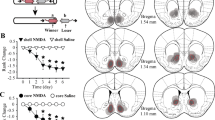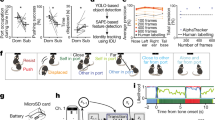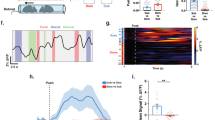Abstract
In most social species, the attainment of social dominance is strongly affected by personality traits. Dominant individuals show better cognitive abilities, however, whether an individual’s cognition can determine its social status has remained inconclusive. We found that mice show better cognitive abilities tend to possess a higher social rank after cohousing. The dynamic release of acetylcholine (ACh) in the prelimbic cortex (PL) is correlated with mouse dominance behavior. ACh enhanced the excitability of the PL neurons via acetylcholine muscarinic M1 receptors (M1). Inhibition of M1 impaired mice cognitive performance and induced losing in social competition. Mice with M1 deficiency in the PL performed worse on cognitive behavioral tests, and exhibited lower status when re-grouped with others. Elevating ACh level in the PL of subordinate mice induced winning. These results provide direct evidence for the involvement of M1 in social hierarchy and suggest that social rank can be tuned by altering cognition through cholinergic system.
This is a preview of subscription content, access via your institution
Access options
Subscribe to this journal
Receive 13 print issues and online access
$259.00 per year
only $19.92 per issue
Buy this article
- Purchase on Springer Link
- Instant access to full article PDF
Prices may be subject to local taxes which are calculated during checkout





Similar content being viewed by others
References
Sapolsky RM. The influence of social hierarchy on primate health. Science. 2005;308:648–52.
Yeh SR, Fricke RA, Edwards DH. The effect of social experience on serotonergic modulation of the escape circuit of crayfish. Science. 1996;271:366–9.
Rushworth MF, Kolling N, Sallet J, Mars RB. Valuation and decision-making in frontal cortex: one or many serial or parallel systems? Curr Opin Neurobiol. 2012;22:946–55.
Mooney SJ, Peragine DE, Hathaway GA, Holmes MM. A game of thrones: neural plasticity in mammalian social hierarchies. Soc Neurosci. 2014;9:108–17.
Sandi C, Haller J. Stress and the social brain: behavioural effects and neurobiological mechanisms. Nat Rev Neurosci. 2015;16:290–304.
Boogert NJ, Reader SM, Laland KN. The relation between social rank, neophobia and individual learning in starlings. Anim Behav. 2006;72:1229–39.
Barnard CJ, Luo N. Acquisition of dominance status affects maze learning in mice. Behav Process. 2002;60:53–9.
Francia N, Cirulli F, Chiarotti F, Antonelli A, Aloe L, Alleva E. Spatial memory deficits in middle-aged mice correlate with lower exploratory activity and a subordinate status: role of hippocampal neurotrophins. Eur J Neurosci. 2006;23:711–28.
Pravosudov VV, Mendoza SP, Clayton NS. The relationship between dominance, corticosterone, memory, and food caching in mountain chickadees (Poecile gambeli). Hormones Behav. 2003;44:93–102.
Seyfarth RM, Cheney DL. What are big brains for? Proc Natl Acad Sci USA. 2002;99:4141–2.
Fernald RD. Cognitive skills needed for social hierarchies. Cold Spring Harb Symposia Quant Biol. 2014;79:229–36.
Tibbetts EA, Pardo-Sanchez J, Weise C. The establishment and maintenance of dominance hierarchies. Philos Trans R Soc Lond Ser B, Biol Sci. 2022;377:20200450.
Reader SM, Laland KN. Social intelligence, innovation, and enhanced brain size in primates. Proc Natl Acad Sci USA. 2002;99:4436–41.
Nicol CJ, Pope SJ. The effects of demonstrator social status and prior foraging success on social learning in laying hens. Anim Behav. 1999;57:163–71.
Zink CF, Tong Y, Chen Q, Bassett DS, Stein JL, Meyer-Lindenberg A. Know your place: neural processing of social hierarchy in humans. Neuron. 2008;58:273–83.
Dulka BN, Bress KS, Grizzell JA, Cooper MA. Social dominance modulates stress-induced neural activity in medial prefrontal cortex projections to the basolateral amygdala. Neuroscience. 2018;388:274–83.
Wang F, Zhu J, Zhu H, Zhang Q, Lin Z, Hu H. Bidirectional control of social hierarchy by synaptic efficacy in medial prefrontal cortex. Science. 2011;334:693–7.
Zhou T, Zhu H, Fan Z, Wang F, Chen Y, Liang H, et al. History of winning remodels thalamo-PFC circuit to reinforce social dominance. Science. 2017;357:162–8.
Kolb B, Buhrmann K, McDonald R, Sutherland RJ. Dissociation of the medial prefrontal, posterior parietal, and posterior temporal cortex for spatial navigation and recognition memory in the rat. Cereb cortex. 1994;4:664–80.
Wang GW, Cai JX. Disconnection of the hippocampal-prefrontal cortical circuits impairs spatial working memory performance in rats. Behav Brain Res. 2006;175:329–36.
Spellman T, Rigotti M, Ahmari SE, Fusi S, Gogos JA, Gordon JA. Hippocampal-prefrontal input supports spatial encoding in working memory. Nature. 2015;522:309–14.
Miller EK, Freedman DJ, Wallis JD. The prefrontal cortex: categories, concepts and cognition. Philos Trans R Soc Lond Ser B Biol Sci. 2002;357:1123–36.
Abbas AI, Sundiang MJM, Henoch B, Morton MP, Bolkan SS, Park AJ, et al. Somatostatin interneurons facilitate hippocampal-prefrontal synchrony and prefrontal spatial encoding. Neuron. 2018;100:926–39e3.
Tamura M, Spellman TJ, Rosen AM, Gogos JA, Gordon JA. Hippocampal-prefrontal theta-gamma coupling during performance of a spatial working memory task. Nat Commun. 2017;8:2182.
Bicks LK, Koike H, Akbarian S, Morishita H. Prefrontal cortex and social cognition in mouse and man. Front Psychol. 2015;6:1805.
Blakemore SJ. The social brain in adolescence. Nat Rev Neurosci. 2008;9:267–77.
Xing B, Mack NR, Guo KM, Zhang YX, Ramirez B, Yang SS, et al. A subpopulation of prefrontal cortical neurons is required for social memory. Biol psychiatry. 2021;89:521–31.
Ballinger EC, Ananth M, Talmage DA, Role LW. Basal forebrain cholinergic circuits and signaling in cognition and cognitive decline. Neuron. 2016;91:1199–218.
Picciotto MR, Higley MJ, Mineur YS. Acetylcholine as a neuromodulator: cholinergic signaling shapes nervous system function and behavior. Neuron. 2012;76:116–29.
Shirey JK, Brady AE, Jones PJ, Davis AA, Bridges TM, Kennedy JP, et al. A selective allosteric potentiator of the M1 muscarinic acetylcholine receptor increases activity of medial prefrontal cortical neurons and restores impairments in reversal learning. J Neurosci. 2009;29:14271–86.
Digby GJ, Noetzel MJ, Bubser M, Utley TJ, Walker AG, Byun NE, et al. Novel allosteric agonists of M1 muscarinic acetylcholine receptors induce brain region-specific responses that correspond with behavioral effects in animal models. J Neurosci. 2012;32:8532–44.
Higashino K, Ago Y, Umeki T, Hasebe S, Onaka Y, Hashimoto H, et al. Rivastigmine improves isolation rearing-induced prepulse inhibition deficits via muscarinic acetylcholine receptors in mice. Psychopharmacology. 2016;233:521–8.
Gulledge AT, Bucci DJ, Zhang SS, Matsui M, Yeh HH. M1 receptors mediate cholinergic modulation of excitability in neocortical pyramidal neurons. J Neurosci. 2009;29:9888–902.
Williams SR, Fletcher LN. A dendritic substrate for the cholinergic control of neocortical output neurons. Neuron. 2019;101:486–99e4.
Xing B, Mack NR, Zhang YX, McEachern EP, Gao WJ. Distinct roles for prefrontal Dopamine D1 and D2 neurons in social hierarchy. J Neurosci. 2022;42:313–24.
Fan Z, Zhu H, Zhou T, Wang S, Wu Y, Hu H. Using the tube test to measure social hierarchy in mice. Nat Protoc. 2019;14:819–31.
Shen Y, Hua L, Yeh CK, Shen L, Ying M, Zhang Z, et al. Ultrasound with microbubbles improves memory, ameliorates pathology and modulates hippocampal proteomic changes in a triple transgenic mouse model of Alzheimer’s disease. Theranostics. 2020;10:11794–819.
Pan L, Zheng L, Wu X, Zhu Z, Wang S, Lu Y, et al. A short period of early life oxytocin treatment rescues social behavior dysfunction via suppression of hippocampal hyperactivity in male mice. Mol Psychiatry. 2022;27:4157–71.
Chen YH, Wu JL, Hu NY, Zhuang JP, Li WP, Zhang SR, et al. Distinct projections from the infralimbic cortex exert opposing effects in modulating anxiety and fear. J Clin Investig. 2021;131:e145692.
Zhang SR, Wu JL, Chen H, Luo R, Chen WJ, Tang LJ, et al. ErbB4 knockdown in serotonergic neurons in the dorsal raphe induces anxiety-like behaviors. Neuropsychopharmacol. 2020;45:1698–706.
Jaafari Suha A, Hosseinmardi N, Janahmadi M. Spatial working memory is disparately interrelated with social status through different developmental stages in rats. Behav Brain Res. 2022;416:113547.
Langley EJG, van Horik JO, Whiteside MA, Beardsworth CE, Madden JR. The relationship between social rank and spatial learning in pheasants, Phasianus colchicus: cause or consequence? PeerJ. 2018;6:e5738.
Langley EJG, van Horik JO, Whiteside MA, Madden JR. Group social rank is associated with performance on a spatial learning task. R Soc Open Sci. 2018;5:171475.
Sun Q, Zhang J, Li A, Yao M, Liu G, Chen S, et al. Acetylcholine deficiency disrupts extratelencephalic projection neurons in the prefrontal cortex in a mouse model of Alzheimer’s disease. Nat Commun. 2022;13:998.
Pezze MA, Marshall HJ, Cassaday HJ. Scopolamine impairs appetitive but not aversive trace conditioning: role of the medial prefrontal cortex. J Neurosci. 2017;37:6289–98.
Jing M, Li Y, Zeng J, Huang P, Skirzewski M, Kljakic O, et al. An optimized acetylcholine sensor for monitoring in vivo cholinergic activity. Nat Methods. 2020;17:1139–46.
Noh K, Cho WH, Lee BH, Kim DW, Kim YS, Park K, et al. Cortical astrocytes modulate dominance behavior in male mice by regulating synaptic excitatory and inhibitory balance. Nat Neurosci. 2023;26:1541–54.
Karvat G, Kimchi T. Acetylcholine elevation relieves cognitive rigidity and social deficiency in a mouse model of autism. Neuropsychopharmacol. 2014;39:831–40.
Proulx E, Suri D, Heximer SP, Vaidya VA, Lambe EK. Early stress prevents the potentiation of muscarinic excitation by calcium release in adult prefrontal cortex. Biol Psychiatry. 2014;76:315–23.
Wohleb ES, Wu M, Gerhard DM, Taylor SR, Picciotto MR, Alreja M, et al. GABA interneurons mediate the rapid antidepressant-like effects of scopolamine. J Clin Investig. 2016;126:2482–94.
Zhu H, Yan H, Tang N, Li X, Pang P, Li H, et al. Impairments of spatial memory in an Alzheimer’s disease model via degeneration of hippocampal cholinergic synapses. Nat Commun. 2017;8:1676.
Chou YJ, Ma YK, Lu YH, King JT, Tasi WS, Yang SB, et al. Potential cross-species correlations in social hierarchy and memory between mice and young children. Commun Biol. 2022;5:230.
Varholick JA, Bailoo JD, Palme R, Wurbel H. Phenotypic variability between Social Dominance Ranks in laboratory mice. Sci Rep. 2018;8:6593.
Varholick JA, Pontiggia A, Murphy E, Daniele V, Palme R, Voelkl B, et al. Social dominance hierarchy type and rank contribute to phenotypic variation within cages of laboratory mice. Sci Rep. 2019;9:13650.
Taborsky B, Oliveira RF. Social competence: an evolutionary approach. Trends Ecol Evolut. 2012;27:679–88.
Fujii N, Hihara S, Nagasaka Y, Iriki A. Social state representation in prefrontal cortex. Soc Neurosci. 2009;4:73–84.
Friedman A, Homma D, Gibb LG, Amemori K-I, Rubin SJ, Hood AS, et al. A corticostriatal path targeting striosomes controls decision-making under conflict. Cell. 2015;161:1320–33.
Hillman KL, Bilkey DK. Neural encoding of competitive effort in the anterior cingulate cortex. Nat Neurosci. 2012;15:1290–7.
Holroyd CB, McClure SM. Hierarchical control over effortful behavior by rodent medial frontal cortex: a computational model. Psychol Rev. 2015;122:54–83.
Hosokawa T, Watanabe M. Prefrontal neurons represent winning and losing during competitive video shooting games between monkeys. J Neurosci. 2012;32:7662–71.
Oda S, Tsuneoka Y, Yoshida S, Adachi-Akahane S, Ito M, Kuroda M, et al. Immunolocalization of muscarinic M1 receptor in the rat medial prefrontal cortex. J Comp Neurol. 2018;526:1329–50.
Zhang C, Zhu H, Ni Z, Xin Q, Zhou T, Wu R, et al. Dynamics of a disinhibitory prefrontal microcircuit in controlling social competition. Neuron. 2022;110:516–31e6.
Obermayer J, Luchicchi A, Heistek TS, de Kloet SF, Terra H, Bruinsma B, et al. Prefrontal cortical ChAT-VIP interneurons provide local excitation by cholinergic synaptic transmission and control attention. Nat Commun. 2019;10:5280.
Esaki H, Deyama S, Izumi S, Katsura A, Nishikawa K, Nishitani N, et al. Varenicline enhances recognition memory via alpha7 nicotinic acetylcholine receptors in the medial prefrontal cortex in male mice. Neuropharmacology. 2023;239:109672.
Esaki H, Izumi S, Fukao A, Ito S, Nishitani N, Deyama S, et al. Nicotine enhances object recognition memory via stimulating alpha4beta2 and alpha7 nicotinic acetylcholine receptors in the medial prefrontal cortex of mice. Biol Pharm Bull. 2021;44:1007–13.
Levey AI, Kitt CA, Simonds WF, Price DL, Brann MR. Identification and localization of muscarinic acetylcholine receptor proteins in brain with subtype-specific antibodies. J Neurosci. 1991;11:3218–26.
Kurowski P, Gawlak M, Szulczyk P. Muscarinic receptor control of pyramidal neuron membrane potential in the medial prefrontal cortex (mPFC) in rats. Neuroscience. 2015;303:474–88.
Satake T, Mitani H, Nakagome K, Kaneko K. Individual and additive effects of neuromodulators on the slow components of afterhyperpolarization currents in layer V pyramidal cells of the rat medial prefrontal cortex. Brain Res. 2008;1229:47–60.
Zhao LX, Chen MW, Qian Y, Yang QH, Ge YH, Chen HZ, et al. M1 muscarinic receptor activation rescues beta-amyloid-induced cognitive impairment through AMPA receptor GluA1 subunit. Neuroscience. 2019;408:239–47.
Zhao LX, Ge YH, Li JB, Xiong CH, Law PY, Xu JR, et al. M1 muscarinic receptors regulate the phosphorylation of AMPA receptor subunit GluA1 via a signaling pathway linking cAMP-PKA and PI3K-Akt. FASEB J. 2019;33:6622–31.
Fan Z, Chang J, Liang Y, Zhu H, Zhang C, Zheng D, et al. Neural mechanism underlying depressive-like state associated with social status loss. Cell. 2023;186:560–76e17.
Funding
This work was supported by grants from the Guangdong Basic and Applied Basic Research Foundation (2022A1515011987) to J-LW and Scientific Research Starting Foundation for High-level Talents of Meizhou People’s Hospital (KYQD202301 to W-JC, KYQD202302 to J-LW).
Author information
Authors and Affiliations
Contributions
W-JC performed the experiments, HC and Z-ML contributed to experiments, W-YH and J-LW designed the study, J-LW supervised the work. W-JC wrote manuscript with help of J-LW. All authors read and approved the final version of the manuscript.
Corresponding authors
Ethics declarations
Competing interests
The authors declare no competing interests.
Additional information
Publisher’s note Springer Nature remains neutral with regard to jurisdictional claims in published maps and institutional affiliations.
Supplementary information
Rights and permissions
Springer Nature or its licensor (e.g. a society or other partner) holds exclusive rights to this article under a publishing agreement with the author(s) or other rightsholder(s); author self-archiving of the accepted manuscript version of this article is solely governed by the terms of such publishing agreement and applicable law.
About this article
Cite this article
Chen, WJ., Chen, H., Li, ZM. et al. Acetylcholine muscarinic M1 receptors in the rodent prefrontal cortex modulate cognitive abilities to establish social hierarchy. Neuropsychopharmacol. 49, 974–982 (2024). https://doi.org/10.1038/s41386-023-01785-z
Received:
Revised:
Accepted:
Published:
Issue Date:
DOI: https://doi.org/10.1038/s41386-023-01785-z



